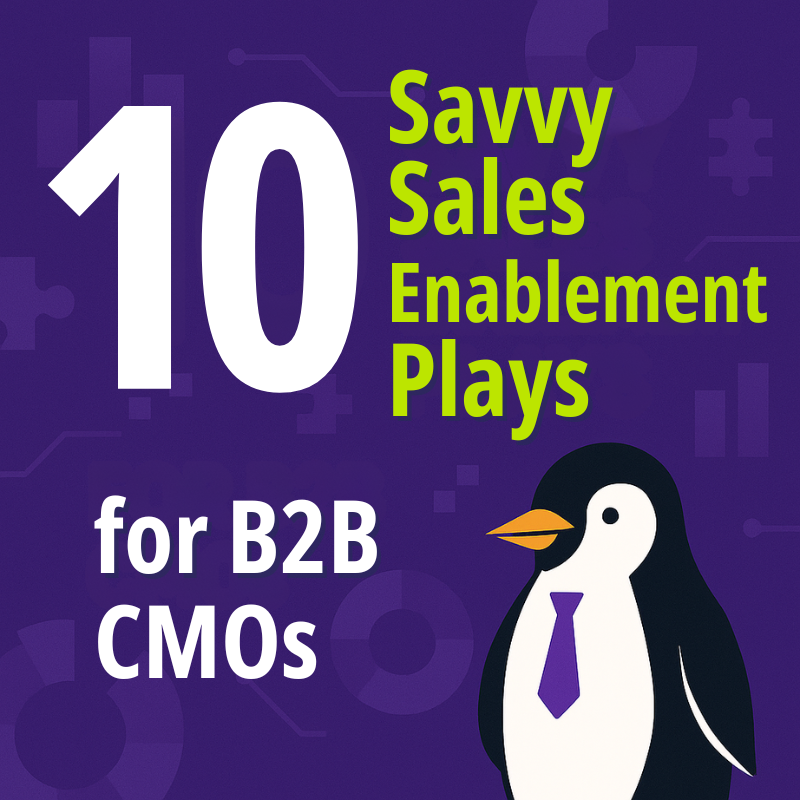How to Stop Random Acts of Content and Start Fueling Revenue:
B2B marketing leaders tell me the same story on repeat: “We build slick decks and elegant one-pagers, but Sales keeps using that ancient slide with the 2019 logo. Meanwhile, I’m drowning in last-minute requests.”
Finding the sweet spot between ad-hoc support and repeatable, high-impact enablement is the modern marketer’s tightrope walk. The good news? 2025’s toolkit gives us fresh options, from AI copilots to self-serve buyer hubs. Below are ten approaches that move Sales Enablement from a reactive order-taking process to a revenue-generating machine, with real-world proof that they work. Grab your virtual hard hat; we’re rebuilding the bridge between Marketing and Sales.
1. Netflix for Decks: AI-Powered Content Recommendations
The idea – Your content library watches deals like Netflix watches viewers, then serves up the perfect asset for each scene.
How it works – AI analyzes CRM data, buyer signals, and objection keywords. A representative on a call with a mid-market fintech prospect might instantly see a case study on similar clients, along with a pricing FAQ slide deck.
Implementation Fast Lane – Platforms such as Highspot now embed recommendation engines; power users even integrate custom models into their own portals.
Proof in practice: HubSpot fused AI recommendations with a shared content hub. Reps closed 31 percent more deals and shortened cycles because they finally used the freshest stories instead of guesswork.
AI-Powered Content Recommendation Engines
- Highspot Copilot – Uses large-language-model smarts to predict which asset will move the deal forward, right inside the rep’s workflow.
- Showpad – Combines content management with AI tagging so collateral surfaces automatically during calls and emails.
- GTM Buddy – An overlay for Salesforce/HubSpot that recommends slides, answer snippets, and customer stories based on real-time CRM context.
2. Let Buyers Drive: Self-Service Digital Deal Rooms
The idea – Enable the buying committee directly rather than forcing every question through a rep.
How it works – Prospects receive a secure microsite holding ROI calculators, timeline templates, security docs, and peer references. They binge at 11 p.m., your team sleeps soundly, and the deal still moves forward.
Implementation Accelerator – Dock, Seismic, and Arrows build branded rooms with engagement analytics so you know when legal popped the cork on your MSA.
Why it matters: 100 Percent Financed used buyer-facing hubs inside HubSpot. The result: 2,028 SQLs, 358 new customers, and a 1,274 percent ROI—all while the enablement team stopped chasing “can you send me that PDF?” emails.
Buyer Enablement Platforms
- Dock – Spins up branded digital deal rooms with ROI calculators, case studies, and contract workflows—plus analytics on every click.
- Arrows – HubSpot-native workspace that lets reps co-build mutual action plans with prospects (great for complex onboardings).
- Seismic Digital Sales Rooms – Enterprise-grade buyer portals that track stakeholder engagement across long buying cycles.
3. Whisper in Their Ear: Real-Time Call Coaching
The idea – AI listens, interprets tone and content, then flashes on-screen prompts: “Ask about budget” or “Handle the ‘we already use X’ objection.”
How it works – Integrations with Gong, Chorus, or Revenue.io parse speech patterns and sentiment, triggering nudges or sending tricky moments to a human coach.
Implementation Fast Lane – Start with auto-generated post-call scorecards, then graduate to live coaching once reps trust the machine-generated insights.
Boost you’ll believe: Infermedica layered Gong intelligence on top of a newly streamlined HubSpot CRM. Their 100-person global team slashed admin time and sharpened calls, freeing up hours every week for more selling.
Real-Time Sales Coaching with Conversation Intelligence Tools
- Gong – Live transcription and AI prompts guide reps to ask budget questions, handle objections, and set next steps.
- Chorus – Flags sentiment shifts and competitive mentions mid-call, then recommends talk tracks proven to win.
- Revenue.io – Goes beyond call analysis with real-time coaching plus automated follow-up tasks inside your CRM.
4. Pipeline Play-Acting: Predictive Role-Plays
The idea – Your next mock objection clinic is powered by your actual pipeline data, not generic scripts.
How it works – Tools like Quantified and Second Nature build AI personas mirroring prospects in current deals (industry, pains, typical pushbacks). Reps practice, receive granular feedback, and re-try until they nail the close.
Implementation fast lane – Pull last quarter’s win/loss notes into the simulator so coaching mirrors real-world landmines.
Why it’s gold: High-growth SaaS teams using predictive role-play report faster ramp times and higher attainment because reps rehearse game-day scenarios, not hypotheticals.
Predictive Practice & Role-Playing Tools
- Second Nature – “Jenny,” the virtual buyer, grills reps with AI-generated objections tailored to their pipeline.
- Quantified – Imports your win/loss data to create lifelike avatars; new 3.0 engine boosts realism and personalized feedback.
- MeetRecord Role-Play – Library of scenario templates plus scoring rubrics for quick peer-to-peer drills.
5. Snack Time Learning: Micro-Modules on Tap
The idea – Instead of eight-hour boot camps, deliver two-minute bursts exactly when the skill is needed.
How it works – A rep struggling at “proposal sent” triggers a one-click video on pricing psychology, right inside the CRM.
Implementation fast lane – Mobile-first platforms tie enablement content to deal stages so training feels like part of the workflow, not homework.
Real-world win: Gymshark focused on just-in-time email best practices. That micro-training alone bumped open rates 20 percent and ignited a growth spurt, proving that small bites can become a feast.
Micro-Learning & Just-in-Time Training Tools
- Spekit – Surfaces 90-second “speks” inside Salesforce, Outreach, or any web app when reps hover over a field or button.
- Whatfix – In-app walkthroughs and pop-up how-tos driven by usage analytics to patch specific knowledge gaps.
- Axonify – Gamified daily quizzes that reinforce product and process know-how, proven to boost long-term recall.
6. Always-Fresh Battle Cards: Competitive Intel on Autopilot
The idea – Your battle cards update themselves whenever a competitor changes pricing, releases a feature, or lands press.
How it works – Tools like Crayon scrape public sources and pair them with your win/loss notes. Reps see the latest differentiators without waiting for Marketing to manually rewrite slides.
Implementation fast lane – Automate alerts so a major competitive move triggers the enablement chat channel and adds new slides to the library.
Case in point: At one cybersecurity firm, automated cards cut prep time for competitive deals by 50 percent and boosted win rates vs. a primary rival by 12 points.
Dynamic Battle Cards & Competitive Intelligence Tools
- Crayon – Aggregates competitor moves, pricing changes, and reviews; auto-updates win-ready battle cards.
- Kompyte – Monitors hundreds of data points (ads, job posts, social) and pushes only the actionable bits to reps.
- Klue – AI “Compete Agent” curates intel and pipes personalized counters into every competitive deal.
7. One Team, One Number: RevOps Alignment
The idea – Merge Marketing, Sales, and Customer Success around shared metrics: pipeline velocity, expansion ARR, and churn reduction.
How it works – Unified dashboards reveal bottlenecks; cross-functional “revenue squads” own fixes. Everyone plays offense on the same scoreboard.
Implementation fast lane – Adopt a RevOps platform or, at a minimum, a shared OKR system. Weekly pipeline standups replace siloed status meetings.
HubSpot’s example: Their unified revenue team is legendary. Customers report a 72 percent higher perceived sales efficiency because handoffs have vanished and messaging has stayed consistent from the first click to renewal.
Revenue-Ops Integration Tools
- Clari – Unifies forecast, pipeline health, and activity data so Marketing, Sales, and CS stare at one truth.
- LeanData – The routing and orchestration layer that keeps leads, contacts, and opportunities perfectly synced.
- Syncari – Harmonizes data models across your stack and auto-heals dirty fields before they wreck dashboards.
8. Try Before You Buy: Interactive Product Demos
The idea – Prospects roam a self-guided sandbox while trackers show what caught their eye.
How it works – Demostack or Reprise clones your UI, hides jet-engine complexity, and personalizes flows. Sales sees that the CFO spent five minutes on the compliance tab, cueing tailored follow-up.
Implementation fast lane – Start with your highest-value use case, layer custom data tokens, and slap the link into your digital deal room from Approach 2.
Results worth sharing: SaaS vendors using interactive demos report up to 30% higher conversion from the first meeting to technical evaluation because buyers build conviction early.
Interactive Product Demonstrations & Simulations Tools
- Demostack – Spins sandbox-free demos that can be personalized in minutes (no engineering needed).
- Supademo – Record-once, share-everywhere guided tours with AI voice-overs and localization baked in.
- Walnut.io– Analytics-rich product simulations that show which feature clicks correlate with win rates.
9. Friends Who Sell Together: Partner Enablement
The idea – Channel partners and resellers should pitch like insiders, not distant cousins.
How it works – A partner portal delivers role-based access to decks, pricing calculators, and training quizzes. Leaderboards and spiffs keep external reps sharp.
Implementation Fast Lane – Tie portal access to certification levels so that the best-trained partners have access to premium assets and co-op marketing dollars.
Why it scales: In verticals such as manufacturing tech, partner-sourced revenue can top 50 percent of new ARR. A single source of enablement truth prevents message drift and rogue discounting.
Ecosystem & Partner Enablement Tools
- PartnerStack – Automates onboarding, deal registration, and payouts for affiliates, resellers, and tech partners.
- Impartner PRM – Award-winning portal with learning paths, certification, and co-marketing workspaces.
Allbound – Gamified partner hub featuring playbooks, certification badges, and integrated deal reg.
10. Never Settle: Continuous Process Tuning
The idea – Treat your sales process like a SaaS product—release notes every month.
How it works – Combine win/loss interviews, buyer surveys, and funnel metrics. Small experiments run, results post to a revenue wiki, and successful tweaks roll out globally.
Implementation Fast Lane – Create a recurring “Process Retro” featuring senior sellers, SDRs, marketers, and CS. Rank ideas by impact vs. effort, and implement two per sprint.
Infermedica’s lesson: Their monthly retros, powered by HubSpot dashboards, uncovered a follow-up gap on warm MQLs. A simple sequence fix delivered a measurable bump in SQL creation within two weeks.
Continuous Sales-Process Optimization Tools
- Clozd – Win-loss interviews plus a platform that pipes buyer feedback straight into your CRM and dashboards.
- Flowla – Maps current workflows, spots automation gaps, and recommends AI-powered fixes to speed cycle time.
- HubSpot Sales Hub – Combines pipeline analytics, sequence testing, and A/B email insights for ongoing tweaks.
Bringing It All Together
Sales Enablement in 2025 is not about churning out more collateral or scheduling another half-day workshop. It is about architecting systems where:
- Content finds the rep at the exact moment buyers need proof.
- Buyers self-educate without waiting on an email response.
- AI augments every conversation—from the first cold call to the renewal handshake.
- Revenue teams share ownership of the entire journey.
The case histories show the payoff:
- HubSpot proved that a single revenue engine closes more deals faster.
- 100 Percent Financed showed that integrated inbound and enablement can spin revenue gold.
- Infermedica demonstrated the power of scalable infrastructure paired with coaching intelligence.
- Gymshark reminded us that polishing core motions—like email—still drives outsized gains.
Your First Three Moves
- Audit content usage – Identify the 10 pieces reps actually send. Feed those into an AI recommendation pilot.
- Build a minimal viable deal room – One shared folder, one ROI calculator, one customer video. Measure engagement.
- Schedule a RevOps summit – Align on three shared revenue KPIs and eliminate any metrics that breed departmental turf wars.
Do this, and the next time Sales pings you for “something quick,” you can reply, “Already in your portal—and by the way, the prospect viewed it twice.” That’s the moment when enablement graduates from reactive helper to indispensable growth engine.
Happy selling, smarter enabling, and may your decks forever auto-update.

